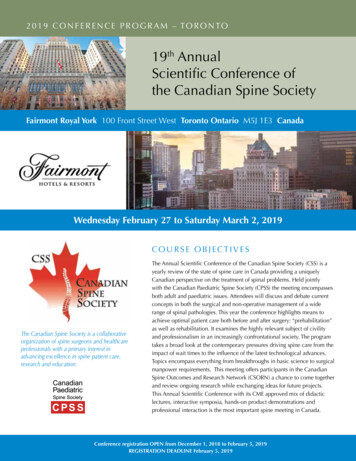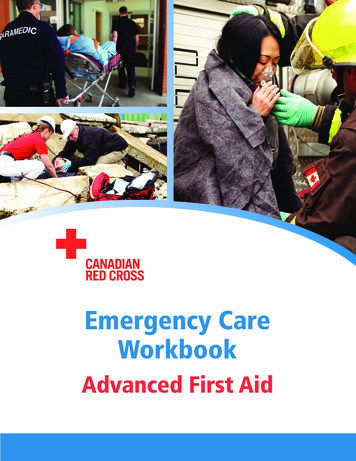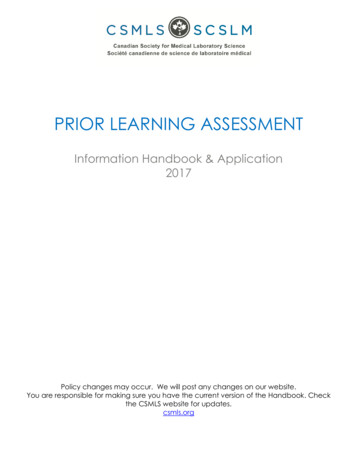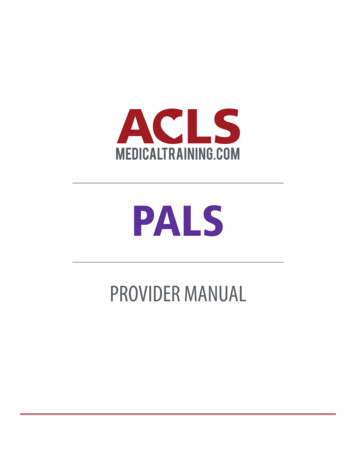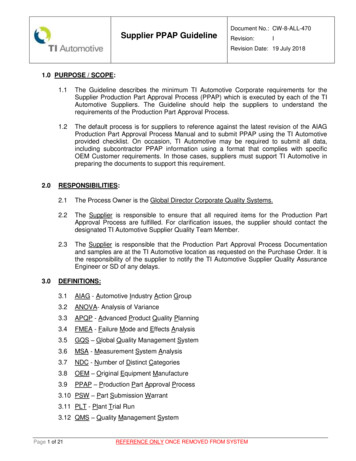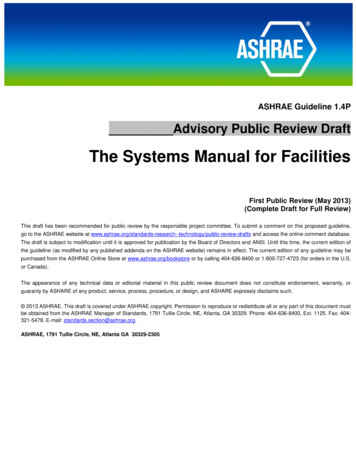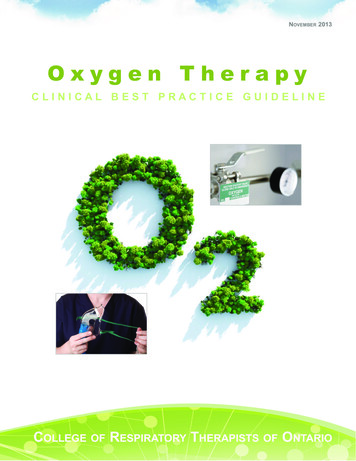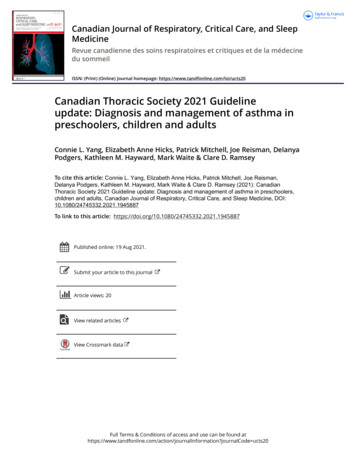
Transcription
Canadian Journal of Respiratory, Critical Care, and SleepMedicineRevue canadienne des soins respiratoires et critiques et de la médecinedu sommeilISSN: (Print) (Online) Journal homepage: https://www.tandfonline.com/loi/ucts20Canadian Thoracic Society 2021 Guidelineupdate: Diagnosis and management of asthma inpreschoolers, children and adultsConnie L. Yang, Elizabeth Anne Hicks, Patrick Mitchell, Joe Reisman, DelanyaPodgers, Kathleen M. Hayward, Mark Waite & Clare D. RamseyTo cite this article: Connie L. Yang, Elizabeth Anne Hicks, Patrick Mitchell, Joe Reisman,Delanya Podgers, Kathleen M. Hayward, Mark Waite & Clare D. Ramsey (2021): CanadianThoracic Society 2021 Guideline update: Diagnosis and management of asthma in preschoolers,children and adults, Canadian Journal of Respiratory, Critical Care, and Sleep Medicine, DOI:10.1080/24745332.2021.1945887To link to this article: shed online: 19 Aug 2021.Submit your article to this journalArticle views: 20View related articlesView Crossmark dataFull Terms & Conditions of access and use can be found ation?journalCode ucts20
Canadian Journal of Respiratory, Critical Care, and Sleep 887CTS GUIDELINES AND POSITION PAPERSCanadian Thoracic Society 2021 Guideline update: Diagnosisand management of asthma in preschoolers, children and adultsConnie L. Yanga, Elizabeth Anne Hicksb, Patrick Mitchellc, Joe Reismand, Delanya Podgerse, Kathleen M.Haywardf, Mark Waiteg and Clare D. RamseyhDepartment of Pediatrics, British Columbia Children’s Hospital, University of British Columbia, Vancouver, British Columbia, Canada;Pediatric Department, University of Alberta, Edmonton, Alberta, Canada; cDepartment of Medicine, University of Calgary, Calgary, Alberta,Canada; dPediatric Department, University of Ottawa, Children’s Hospital of Eastern Ontario, Ottawa, Ontario, Canada; eKingston HealthSciences Centre, Kingston, Ontario, Canada; fCalgary COPD & Asthma Program, Alberta Health Services, Calgary, Alberta, Canada;gDepartment of Family Medicine, The Moncton Hospital, Moncton, New Brunswick, Canada; hDepartment of Medicine, Rady Facultyof Health Sciences, University of Manitoba, Winnipeg, Manitoba, CanadaabIntroductionThis document incorporates recommendations from the 2021Canadian Thoracic Society (CTS) Guideline – A FocusedUpdate on the Management of Very Mild and Mild Asthma1with previous statements and recommendations from theCTS 20102 and 20123 asthma guidelines and the CTS/Canadian Pediatric Society 2015 position statement on thediagnosis and management of asthma in preschoolers.4 Forthe evidence and rationale informing those recommendationsand detailed information about preschool asthma, usersshould refer to the original documents.1–4 Recommendationsfrom previous CTS guidelines were reviewed using the CTSGuideline Update Policy, the review process based on the“living guideline” concept, to determine if the informationwas still relevant and accurate.5 The recommendations fromthe CTS 2017 Severe Asthma Guideline6 have not been incorporated as severe asthma is typically managed in subspecialtyclinics, but may be incorporated in future guideline updates.Summary of new features1 compared to the 2012guideline31.Treatment for very mild asthma. Patients on as needed(PRN) use of a SABA with well-controlled asthma athigher risk for asthma exacerbation should have treatment escalated to daily inhaled corticosteroids (ICS) PRN SABA (all ages) or PRN budesonide/formoterol(bud/form) ( 12 years of age) (Figure 3). Daily ICS (allages) or PRN bud/form ( 12 years of age) are alsooptions for patients on PRN SABA with well-controlledasthma who are not at higher risk for exacerbation, ifthey prefer to have better asthma control and todecrease their risk of asthma exacerbation.Previous guidance: Patients with very mild intermittent asthma may be treated with PRN SABA. ICSshould be prescribed for those with symptoms even“less than 3 times a week,” those with mild loss ofcontrol, or those presenting with an asthma exacerbation requiring systemic steroids.2. Treatment for mild asthma. Patients on PRN SABAwith poorly-controlled asthma (as per updated CTScriteria) should have treatment escalated to dailyICS PRN SABA. For individuals 12 years of agenot controlled on PRN SABA who have poor adherence to daily ICS despite substantial asthma education and support, PRN bud/form is recommendedover daily ICS PRN SABA (Figure 3).Previous guidance: Use of an ICS/LABA combinationas a reliever in lieu of a fast-acting beta-agonist(FABA) alone was not recommended.3. Assessing risk of exacerbation in addition to asthmacontrol. When deciding on optimal treatment, inaddition to evaluating asthma control, risk of asthmaexacerbation should be assessed based on the criteriapresented in Table 3.Previous guidance: Exacerbations should be mild andinfrequent, and some risk factors for exacerbation wereincluded within the Asthma Control criteria.4. Change in control criteria for daytime symptoms andfrequency of reliever need. Those with well-controlledasthma should have daytime symptoms 2 days perweek and need for reliever (SABA or PRN bud/form) 2 doses per week. For preschoolers, the frequency ofsymptoms has been changed from 8 days/month to 8 days/month to align with criteria for older patients.Previous guidance: Good asthma control if 4 daysper week of daytime symptoms or 4 doses per weekof FABA.5. Clarification for criteria of mild versus severeasthma exacerbation. A severe asthma exacerbationis one that requires either systemic steroids, an emergency department (ED) visit or hospitalization. Amild exacerbation is an increase in asthma symptomsCONTACT Connie L. YangConnie.Yang@cw.bc.caDepartment of Pediatrics, British Columbia Children’s Hospital, University of British Columbia, 4480Oak Street, Rm 1C31A, Vancouver, British Columbia, V6H 3V4 Canada. 2021 Canadian Thoracic Society
2C. L. YANG ET AL.6.7.from baseline that does not require systemic steroids,an ED visit or a hospitalization.Previous guidance: Severity of exacerbations was notspecifically defined.Update of severity classification. Reclassification ofasthma severity to remove the very severe categoryto align with the Recognition and Management ofSevere Asthma Position Statement,6 and to includeother asthma therapies.Previous guidance: Categories such as “mild intermittent” and “mild persistent” asthma were referred to inprevious guidelines but are no longer used. This terminology can lead to a misunderstanding of theunderlying pathophysiology of asthma as the term“mild intermittent” may suggest to patients thatthere are times when they do not have asthma whenin fact, asthma is a chronic condition and it is onlythe symptoms that can be intermittent.Asthma continuum and ICS dosing table. ReferenceICS for dosing in the continuum has been changedto fluticasone propionate equivalents. SABA or bud/form as needed has been extended across the bottomof the continuum (Figure 2). Dosing categories andtreatments have been expanded in the continuum andICS dosing table (Table 8) to include preschoolers.Previous guidance: Historically asthma guidelines usedbeclomethasone equivalents; however, this can lead toconfusion when comparing to other guidelines andreviewing clinical trials as there are 2 forms of beclomethasone available in other countries with different potencies.Asthma definitionIt is recognized that asthma is a heterogenous disordercompromised of many different phenotypes with an increasedunderstanding of the various endotypes or mechanistic pathways. Although some advocate viewing asthma as a component of its parts or treatable traits, outside of severeasthma, current evidence is not to the point where treatmentrecommendations can be based on phenotypes or endotypes,although trials utilizing this approach are being conducted.7,8The definition of asthma remains unchanged from the previous CTS 2012 Asthma Guideline:Asthma is an inflammatory disorder of the airways characterized by paroxysmal or persistent symptoms such asdyspnea, chest tightness, wheezing, sputum production andcough, associated with variable airflow limitation and airway hyper-responsiveness to endogenous or exogenous stimuli. Inflammation and its resultant effects on airway structureand function are considered to be the main mechanismsleading to the development and maintenance of asthma.3Asthma diagnosisThe diagnosis of asthma is based on a compatible clinicalhistory (see previous definition) with objective evidence ofreversible airflow obstruction (Table 1). In patients 6 yearsTable 1. Diagnosis of asthma.PreferredCLINICAL HISTORY COMPATIBLE WITH ASTHMAParoxysmal or persistent symptoms such as dyspnea, chest tightness, wheezing, sputum production, and coughandCONFIRMATION OF REVERSIBLE AIRFLOW OBSTRUCTIONChildren (1-5 years of age)Children (6 years of age and over)Adults (18 years of age and over)Documentation by trained health care Spirometry showing reversible airflowSpirometry showing reversible airflow obstructionprovider of wheeze and other signs of obstructionFEV1/FVC LLN ( 0.75-0.8a)airflow obstruction with documentedFEV1/FVC LLN ( 0.8-0.9a)improvement with SABA /- oralAND increase in FEV1 after a bronchodilator orcorticosteroidsAND increase in FEV after aafter a course of controller therapy of 12% and1AlternativeAlternativeConvincing caregiver report ofwheezing or other symptoms ofairflow obstruction with symptomaticresponse to a 3-month trial of amedium dose of ICS and as neededSABA or symptomatic response toSABAbbronchodilator or after a course ofcontroller therapy of 12%Peak expiratory flowa minimum of 200mL 20% increase after a bronchodilator orafter a course of controller therapyc60L/min (minimum 20%) increase after abronchodilator or after a course of controllertherapycPeak expiratory flowORDiurnal variation 8%12 based on twice dailyreadings; 20% based on multiple daily readingsdPositive challenge testMethacholine PC20 4 mg/ml or PD20 0.5 µmol (100 mcg)PC20 4-16 mg/mL or PD20 0.2-2 µmol (100-400 mcg) is borderlinePC20 16 mg/mL or PD20 2 µmol ( 400 mcg) is negative13ORExercise challenge with 10-15% decrease in FEV1 post-exerciseAbbreviatons: SABA, short-acting beta-agonist; FEV1, forced expiratory volume in 1 second; FVC, forced vital capacity; LLN, lower limit of normal; ICS, inhaledcorticosteroid; PC20, provocative concentration; PD20, provocative dose.aApproximate lower limits of normal ratios for children and adults.bIn children with mild intermittent symptoms and mild exacerbations, the diagnosis is only suggested because the accuracy of parental report of responseto treatment may be unreliable due to misperception and spontaneous improvement of symptoms, which is why confirmation of reversible obstruction bydirect observation from a health care provider is preferred.cComparison of peak expiratory flows should be done on the same device given the variability between devices.dDifference between minimum AM pre-bronchodilator value in 1 week and maximum PM value as % of recent maximum.
Canadian Journal of Respiratory, Critical Care, and Sleep Medicine3Figure 1. Diagnosis algorithm for children 1 to 5 years of age.aDocumentation by a physician or trained health care practitioner.bEpisodes of wheezing with/without difficulty breathing.c Severity of an exacerbation documented by clinical assessment of signs of airflow obstruction, preferably with the addition of objective measures such oxygensaturation and respiratory rate, and/or validated score such as the Pediatric Respiratory Assessment Measure (PRAM) score.d Based on marked improvement in signs of airflow obstruction before and after therapy or a reduction of 3 points on the PRAM score, recognizing theexpected time response to therapy.e A conclusive therapeutic trial hinges on adequate dose of asthma medication, adequate inhalation technique, diligent documentation of the signs and/orsymptoms, and timely medical reassessment; if these conditions are not met, consider repeating the treatment or therapeutic trial.f The diagnosis of asthma is based on recurrent ( 2) episodes of asthma-like exacerbations (documented signs) and/or symptoms. In case of a first occurrenceof exacerbation with no previous asthma-like symptoms, the diagnostic of asthma is suspected and can be confirmed with re-occurrence of asthma-likesymptoms or exacerbations with response to asthma therapy.g 8 days/month with asthma-like symptoms.h Severe exacerbations require any of the following: systemic steroids, hospitalization; or an emergency department visit.I In this age group, the diagnostic accuracy of parental report of a short-term response to as-needed short-acting β2-agonist (SABA) may be unreliable due tomisperception and/or spontaneous improvement of another condition. Documentation of airflow obstruction and reversibility when symptomatic, by a physicianor trained health care practitioner, is preferred.j Based on 50% fewer severe exacerbations, shorter and milder exacerbations, and fewer, milder symptoms between episodes.of age and over, spirometry demonstrating reversible airflowobstruction is the preferred method of confirming a diagnosis of asthma. Since spirometry has a higher specificitythan sensitivity for diagnosing asthma, normal spirometrydoes not rule out a diagnosis of asthma.9The diagnosis of asthma should be considered in children1 to 5 years of age with recurrent asthma-like symptoms orexacerbations, even if triggered by viral infections. In childrenunder the age of 6, a compatible clinical history, physicalexam and trial of treatment are used to make a clinical diagnosis (Table 1, Figure 1). Given that up to 50% of childrenunder the age of 6 outgrow their symptoms, a monitoredtrial off medication can be attempted when asthma iswell-controlled with exposure to the child’s typical triggers,including no exacerbations, for at least 3-6 months.10,11Asthma managementThe core components of asthma management are highlightedin the asthma management continuum (Figure 2) andinclude: 1) Assessing asthma control and risk of exacerbation,2) Providing asthma self-management education including awritten action plan, 3) Identifying triggers and discussingenvironmental control if applicable, and 4) Prescribing
4C. L. YANG ET AL.Figure 2. 2021 Asthma continuum.Management relies on an accurate diagnosis of asthma and regular reassessment of control and risk of exacerbation. All individuals with asthma should beprovided with self-management education, including a written action plan. Adherence to treatment, inhaler technique, exposure to environmental triggers, andthe presence of comorbidities should be reassessed at each visit and optimized.Individuals with well controlled asthma on no medication or PRN SABA at lower risk of exacerbation can use PRN SABA, daily ICS PRN SABA, and if 12 yearsof age PRN bud/form*.Individuals at higher risk of exacerbation even if well-controlled on PRN SABA or no medication, and those with poorly-controlled asthma on PRN SABA or nomedication should be started on daily ICS PRN SABA. In individuals 12 years old with poor adherence despite substantial asthma education and support,PRN bud/form* can be considered. LTRA are second-line monotherapy for asthma. If asthma is not adequately controlled by daily low doses of ICS with goodtechnique and adherence, additional therapy should be considered. In children 1-11 years old, ICS should be increased to medium dose and if still not controlledin children 6-11 years old, the addition of a LABA or LTRA should be considered. In individuals 12 years of age and over, a LABA in the same inhaler as an ICSis first line adjunct therapy. If still not controlled, the addition of a LTRA or tiotropium should be considered.In children who are not well-controlled on medium dose ICS, a referral to an asthma specialist is recommended. After achieving asthma control, including nosevere exacerbations, for at least 3-6 months, medication should be reduced to the minimum necessary dose to maintain asthma control and prevent futureexacerbations.HFA, hydrofluoroalkane; SABA, short-acting beta-agonist, LABA, long-acting beta-agonist, ICS, inhaled corticosteroid, LTRA, leukotriene receptor antagonist, bud/form: budesonide-formoterol in a single inhalerappropriate pharmacologic treatment to achieve and maintainasthma control which includes minimizing exacerbations.Asthma control and risk of exacerbationAsthma control (Table 2) and risk for exacerbation (Table3) should be assessed at each clinical encounter.The goal of asthma treatment is to have well-controlledasthma in order to minimize short- and long-term complications, morbidity and mortality.3 Asthma control is oftenthought of as symptom control; however, the CTS controlcriteria incorporate all facets of asthma control including:1) symptoms and impact on quality of life; 2) exacerbations;3) lung function; and 4) inflammatory markers for adultswith moderate to severe asthma. The use of the fraction ofexhaled nitric oxide (FeNO) as a marker of asthma controlwas assessed in the CTS 2012 asthma guideline3 and wasnot recommended as a routine measurement.For patients with poorly-controlled asthma, potentialreasons for poor control should be assessed and corrected
Canadian Journal of Respiratory, Critical Care, and Sleep Medicine5Table 2. Well-controlled asthma criteria.CharacteristicDaytime symptomsNighttime symptomsPhysical activityExacerbationsAbsence from work or school due to asthmaNeed for a reliever (SABA or bud/form)†FEV1 or PEFPEF diurnal variationSputum eosinophilsFrequency or value 2 days/week 1 night/week and mildNormalMild and infrequent*None 2 doses per week90% of personal best10-15%#2-3% A patient who meets all of the above criteria would be considered to have well-controlled asthma.*A mild exacerbation is an increase in asthma symptoms from baseline that does not require systemic steroids, an ED visit, or ahospitalization. “Infrequent” is not specifically defined, since the frequency of mild exacerbations that patients consider an impairmentto quality of life varies. If the patient feels that the frequency of mild exacerbations is impairing their quality of life, then theirasthma should be considered poorly-controlled. If a patient is having frequent mild exacerbations, they should be assessed todetermine if at baseline, they have poorly-controlled asthma.†There are no established criteria for control when using bud/form as a reliever,; however, use of a reliever often indicates that apatient is having symptoms and is a criterion that can be objectively assessed.#Diurnal variation is calculated as the highest peak expiratory flow (PEF) minus the lowest divided by the highest peak flow multipliedby 100, for morning and night (determined over a 2-week period). Consider in adults 18 years of age with uncontrolled moderate to severe asthma who are assessed in specialist centers.prior to or in conjunction with escalation of pharmacologictherapy. This includes assessment of: adherence, inhalationtechnique and whether they have been using an emptyinhaler, environmental (including occupational) exposuresand key comorbidities (eg, rhinosinusitis, gastro-esophagealreflux, paradoxical vocal fold motion, anxiety anddepression).6Individuals can have well-controlled asthma but stillbe at risk for exacerbation. Specific risk factors for severeexacerbations should be assessed at each clinical encounter(Table 3). These risk factors are particularly important whendeciding on controller therapy for a patient with very mildor mild asthma.A more complete list of risk factors for severe exacerbations (Table 4) and for near-fatal and fatal asthma (Table5) are provided to facilitate discussion between cliniciansand patients about their individual risk. Patients at risk fornear fatal or fatal asthma require careful follow-up, and maybenefit from a multi-disciplinary team, given that factorssuch as non-adherence, substance use and psychiatric illnessincrease their risk of death from asthma.Asthma education and written action planOnce a diagnosis of asthma is made, it is important thatpatients and families receive appropriate asthmaself-management education. Key components of an asthmaeducation program are listed in Table 6.2Written action planWritten asthma action plans are an important part of carefor all patients with asthma.2 They have been shown todecrease exacerbations in children and adults.21,22There is no clear benefit of peak-flow based action plans incomparison to symptom-based action plans.23,24 The choicebetween these 2 types of action plans can be individualizedbased on patient preference and physician judgment, as thereare some circumstances (eg, patients with poor symptom perception) where a peak-flow based action plan may be of benefit.Action plans should outline recommended daily preventive management strategies to maintain control, when andhow to adjust reliever therapy (and controller therapy inadults prone to exacerbations) for loss of control and provide clear instructions regarding when to seek urgent medical attention.2 Treatment in the yellow zone of an actionplan will be discussed in the pharmacologic treatmentsection. Examples of action plans for children and adultscan be found on the CTS website under Guidelines andRes ources at https://cts-s ct.ca/guideline-librar y/knowledge-tools-resources/asthma/Environmental controlEnvironmental factors that trigger a patient’s asthma shouldbe identified on history and avoided, if possible.Approximately 36% of adult-onset asthma cases are probablyor possibly work-related;25 therefore, it is important to perform a thorough medical and occupational history to identify work-related asthma.Evidence for the clinical benefit of specific interventionsto reduce exposure to indoor allergens in all patients withasthma is lacking.26–29 Given the expense and complexity ofthese interventions, these are not recommended as a generalstrategy; however, in patients with asthma symptoms triggered by indoor allergens, it would be prudent to minimizeexposure. The current literature suggests that multi-componentinterventions (eg, use of two or more single-componentinterventions) are more effective than single-componentinterventions (eg, HEPA filters, cleaning products, carpetremoval, pet removal).30First- or secondhand exposure to tobacco smoke is a riskfactor for asthma exacerbations and counseling on smokingcessation should be provided. Smoking marijuana and vapingare increasing in prevalence, particularly among adolescents,
6C. L. YANG ET AL.Table 3. Assessing risk for severe exacerbation.Individuals with any one of these risk factors are at higher risk for asthma exacerbation:1. any history of a previous severe asthma exacerbation (requiring any of the following: systemic steroids, ED visit, or hospitalization)2. poorly controlled asthma as per CTS criteria3. overuse of SABA (defined as use of more than 2 inhalers of SABA in a year)4. current smokerThese risk factors were chosen based on OR of 1.5 for severe exacerbations, certainty of the effect and ease of use in clinical practice.1,14Table 4. Risk factors associated with severe asthma exacerbations.Greatly increased risk (Odds Ratio (OR) 2.5*) 12 years of age6-11 years of age 6 years of ageHistory of previous severe exacerbation History of previous severe exacerbation History of previous severe exacerbation Poorly-controlled asthma FEV1 60% predictedModerate increased risk (OR 1.5-2.5*) Poorly-controlled asthma Excessive SABA use ( 2 inhalers/year) Excessive SABA use ( 2 inhalers/year16) Comorbid atopic/allergic disease Current smoker** Low socioeconomic status Vitamin D deficiency ( 30 nmol/L) FEV1 60-80% predictedSlightly increased risk (OR 1.1-1.5*) Exposure to environmental tobacco smoke** Comorbid atopic/allergic disease Older age (especially 55 years of age) Younger age Raised blood eosinophils ( 300/μL) Female sex Obesity Younger age FEV1 70% predicted Obesity Low parental education Low socioeconomic status Previous smoker** Male sex Depression UnderweightNote. This table is adapted from SIGN 158 - British guideline on the management of asthma by kind permission of the Scottish Intercollegiate GuidelinesNetwork.15*OR reported represent the OR found in the majority of studies examining the risk factor.14,15**Studies have examined the risk of tobacco smoking; however, vaping and smoking of other substances should also be considered risk factors.17,18Table 5. Risk factors associated with near-fatal or fatal asthma.19,20Any previous near-fatal asthma exacerbation (eg, previous intensive care unit (ICU) admission, ventilation, respiratory acidosis)Recurrent hospitalizations or ED visits in last yearSevere asthmaOveruse of SABAPoor adherence to treatment plansFailure to attend clinic appointmentsDepression, anxiety or other psychiatric illnessAlcohol or other substance useObesitySevere domestic, marital, employment, local stressDenial of illness or severity of illnessNote. This table is adapted from SIGN 158 - British guideline on the management of asthma by kind permission of the Scottish Intercollegiate GuidelinesNetwork.15Table 6. Components of an asthma education program.1. A sthma pathophysiology: A chronic inflammatory condition in which airways are hyper-reactive (sensitive) to environmental (allergic, irritant orinfectious) and/or intrinsic factors.2. Identify triggers: Identification and avoidance of environmental triggers specific to the patients.3. A sthma control for all patients: Asthma can be controlled and all patients with asthma can lead a normal life. Regular symptoms, poor lung functionand asthma exacerbations indicate treatment failure.4. Minimal to no exacerbations for all patients: Identify risk factors for asthma exacerbations.5. Reliever vs. controller: The difference between reliever and controller medications and their use in the written action plan.6. Written action plan: Provision and explanation of a written action plan comprising: How and how often to assess asthma control (self-monitoring) Instructions to maintain good control emphasizing adherence to controller medication and making specific environmental changes Signs and symptoms indicating poorly-controlled asthma, with instructions on what to do during loss of control (medication to add or increase, howmuch and how long; when and how to seek additional help (eg, when to go to the hospital or call the health care provider)7. Medication safety and side effects: Expected onset of action and potential side effects of medications.8. Inhaler teaching: Teaching and verification of the inhalation technique specific to the devices prescribed for the patient. Ensuring patients know howto tell when an inhaler is empty.
Canadian Journal of Respiratory, Critical Care, and Sleep Medicine7Table 7. Recommendations for asthma devices by age.37Age1-3 years old4-6 years oldDevicepMDI VHC with maskpMDI VHC with mouthpiece 6 years oldpMDI VHC with mouthpieceor dry powder inhaler 12 years oldand adultsDry powder inhaler or pMDI VHC with mouthpieceTips for useEnsure good seal of face maskTo use a VHC with mouthpiece, patient needs to form a seal around the mouthpiece and cooperatewith instructions. Tidal breathing* can be used with a VHC with mouthpiece.To use a dry powder inhaler, patient needs to be able to inhale deeply and forcefully. Breath-holdtechnique** with VHC with mouthpiece improves lung deposition compared to tidal breathing, andis preferred if patient is able.VHC with masks are also available for adults unable to use a dry powder inhaler or VHC withmouthpiece.Abbreviations: pMDI, pressurized meter dose inhaler; VHC, valved holding chamber.Age recommendations are approximate as device technique needs to be individually assessed.*Tidal breathing: 5-10 tidal breaths per actuation.**Breath-hold technique: Exhale slowly, actuate pMDI, slowly inhale and hold breath for 5 to 10 seconds.and these exposures are increasingly recognized as a causefor respiratory symptoms and risk for exacerbation inpatients with asthma.17,18,31proper inhaler technique, see ls-resources/asthma/.Pharmacologic treatmentAll individuals with asthma should have access to a reliever foruse as needed to treat acute symptoms. In Canada, SABAs(salbutamol, terbutaline), and a combination inhaler (bud/form)are approved for this indication. As needed bud/form is approvedfor use as a reliever in adults and children 12 years of age.Bud/form is not studied and should not be used as areliever when controller medications other than maintenancebud/form are used. The use of bud/form as a reliever inpatients not on a daily controller medication (p 8), and inthose on a fixed dose of bud/form for maintenance (p 8)will be discussed in the Controller Therapy section.Regular need for a reliever (more than 2 doses per week)merits reevaluation to identify the reason(s) forpoorly-controlled asthma. Frequent use of a SABA relieveris a risk factor for severe exacerbations and asthma-relateddeath,16 and the use of more than two inhalers of SABA ina year (typically containing 200 doses each) should promptreevaluation of asthma control.SABAs should only be used for symptom relief andshould not be regularly used “to open the airways” beforedaily controller therapy administration as this has beenshown to increase risk of exacerbations.1Inhaler deviceIt is important to consider the type of inhaler device that apatient prefers to use and can use properly before prescribingasthma medication, as most categories of medication come inmultiple devices (eg, pressurized meter dose inhaler (pMDI),dry powder inhaler; Table 7). Poor inhaler technique
gdepartment of amily Medicine, f the Moncton Hospital, Moncton, new Brunswick, Canada; hdepartment of Medicine, ady faculty r of Health ciences, s university of Manitoba, Winnipeg, Manitoba, Canada Introduction This document incorporates recommendations from the 2021 Canadian Thoracic Society (CTS) Guideline - A Focused

